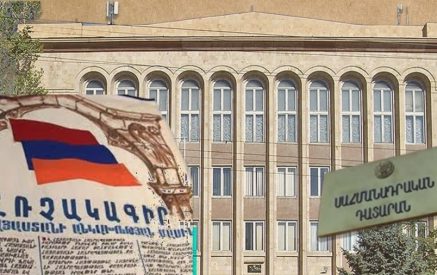In the photos, you can see the city Osnabrück in Germany, which is the birthplace of the 20th-century famous writer Erich Maria Remarque. This city located in the Lower-Saxony region was founded in the VIII century and the name Osnabrück, according to the dictionary of geographical names, consisting of a combination of the name Osna, a 193 km long river running thru the Lower Saxony, now called Hase River, and Brück, a bridge.
Recently, under the framework of program “Cross border observations: reliable coverage of local elections in Lower Saxony and Armenia” organized by the Berlin School of Journalism and the “Journalists for the Future” NGO, we also visited this town together with a group of journalists arriving from Armenia, where our colleagues hurried to present that the true Germany is in this city rather than in Berlin.
To our observation of what a coloring and beautiful city with its specific face, the chief responsible for the Neue Osnabrucker Zeitung print newspaper who was accompanying us, Markus Takenberg, (opportunely, his wife is a Georgian-Armenian and he is very well familiar with Armenian culture) noted, “Every house in this town has its own character and face.” Walking down a little, we reach a building that gives brilliance to Osnabrück, where you can see the photos of the people hanging on the walls who had signed the Westphalia peace agreement after the Thirty Years’ War (1618-1648). Incidentally, the City Council operates right in this building. Wishing peace to the world in Armenian writing in the record-book for the visitors, we continue to wander in the old and colored town of Germany. Marcus Takenberg accompanies us to the Hausbrauerei Rampendahl brewery founded in 1430. This is also one of the symbols of this city. The beer here is unique by its taste. Remarque’s house is also in this historic part of the city where you can always see tourists taking photos, even they stand in a queue. Anyway, the fourth largest city in Lower-Saxony arouses jealousy. Walking down along the historic center of this city and finding some architectural similarities with the second town of Armenia, I am thinking, what prevents Gyumri giving birth to one of the most famous figures of the world in the late 19th-century and early 20th century – the mystic philosopher George Gurdjieff – to make it an attractive site for the tourists.
Read also
I should note that in all the German cities where we visited, everywhere you could see construction works going on, in the literal sense of the word, they are shivering for every building. Osnabrück was also not an exception in this respect. While the historical face of Gyumri – the “Kumayri” historical and architectural reserve-museum, which includes more than 1000 buildings left as a heritage since the 1800-ies is falling day by day. Furthermore, “Kumayri” reserve, which was founded in 1980, to preserve the historic buildings they have appeared on the list of the world’s 100 endangered preserve-museums. And everyone except us is fascinated by this reserve. Lisa Harper, deputy governor of Washington, making a tour in Europe, visiting Gyumri in June, announced that this town changed her life and she is shocked by historical and old streets of Gyumri and the architecture of the buildings of “Kumayri” preserve. She was so charmed that she decided to restore and save a few historical buildings in Gyumri by the grant program in 2017. Note that Ambassador Peter Svitalski, the head of the EU Delegation to Armenia, was also fascinated by Gyumri. He is convinced that Gyumri is the most European city of Armenia, with the biggest potential for tourism development. Despite the admiration of the foreigners, we continue not feeling the value of our town, moreover, after the earthquake, over 27 years we have allowed that this cozy populated area giving birth to eminent figures lose its face, turn into a gray and miserable domik-town with indescribable muddy streets. Returning home, we asked the chief architect of Gyumri, Henrik Gasparyan, whether Gurdjieff’s house is preserved in Gyumri. The architect said that there is no such house, maybe it is destroyed and he does not have precise information. Likewise, there is no Sheram’s house, which was on the Haghtanak Avenue. He also informed us that Gyumri is free from European, especially German culture. “In 1837 when the Russians built the Black Fortress in Gyumri and it became a military base, and a status was granted to the city in 1840, Russian culture into our city, but when you look at all our old buildings, all are built by the example of the building of St. Petersburg, Europe, mainly Germany, the houses there are made of alabaster, ours was made of stone,” -said the architect.
The architecture of Gyumri, according to Henrik Gasparyan, although it is not officially accepted but is describes by the term “Gyumri style”, it is a combination of black and red stones, and in professional term, it is eclectic, i.e. a mixed style. According to the architect, this contains both Russian ambir, our classic and popular architecture – buildings with skylights. Incidentally, the chief architect of Gyumri told also an exciting news to us that every street in every city in Germany had its responsible builder and artist.
Nune AREVSHATYAN
































































